Half-built cars run on overhead factory lines. A car sculpture hangs in the air high off the ground at the Volkswagen-Audi factory in Changchun, north-east China. Welcome to car city.
Volkswagen-Audi's sales in the world's biggest car market are equally stratospheric.
Sales are expected to top 2 million units this year, having notched up a growth of 16.4 per cent in the first half.
That would give the company a bigger order book than the entire industry in the UK this year, helping Volkswagen climb to the number two spot in global car manufacturing for the first time.
Volkswagen's early entry into the market has given it a leading position that it has held on to, especially in the huge market for luxury government cars.
But its achievements in the "dragon economy" have not come without challenges.
Foreign companies seeking to produce vehicles in China must enter a joint venture with a local company, and Volkswagen has forged two such partnerships.
The first was with Shanghai Automotive Industry in 1984, followed seven years later by a tie-up with FAW, another major Chinese car maker, in Changchun.
The two ventures sometimes seem as though they are competing with one another more than with rival manufacturers.
In 2008, for example, Shanghai Volkswagen launched the Lavida, a medium-sized saloon that is sold only in China.
A year later, FAW-Volkswagen debuted a China-only version of its Bora, a car that competes in the same segment as the Lavida.
Things got more complicated still recently with the launch of a new version of a larger car, the Passat.
The Shanghai branch of Volkswagen makes and sells the latest version of this car under its original name, while FAW-Volkswagen makes a car that is almost identical, yet markets it using the model name Magotan.
The two vehicles are barely distinguishable, yet they are advertised separately and sold in different dealerships.
It certainly seems like a potential source of confusion, not to mention inefficiency.
The pitfalls of joint ventureship in China are well documented.
There are many early examples in other industries in which local partners set themselves up in competition with the original venture.
Yet according to Lin Huaibin, a research manager at IHS in Shanghai, Volkswagen's strategy of producing two competing models might have worked well.
In particular, the Bora and the Lavida models appear not to have stolen sales from each other.
"Many people ask, when you launch so many similar models, whether they cannibalise each other. From our observations, it may not be the case," he says.
"It's almost like selling mobile phones. As long as you have different versions with different exteriors, the consumers will buy them.
"It's like Hyundai and Kia. They can launch parallel models with the same platform, but the sales volume is pretty good. It doesn't necessarily lead to cannibalism."
While there may be compromises for Volkswagen in having two partners in China, Mr Lin said there were also advantages.
"On the positive side, you can use each joint-venture as leverage, they can use it as a negotiating bargain. They can balance their interests," he says.
"If you have only one joint-venture partner, you probably will be more highly influenced by the Chinese partner than if you have two.
"Sometimes there can be a negative, because sometimes there could be overlap, but I don't think overall it has been a negative impact."






